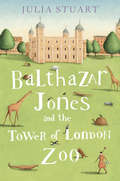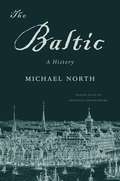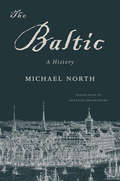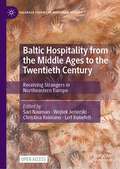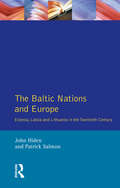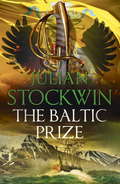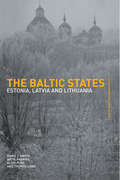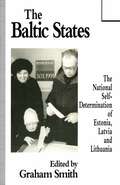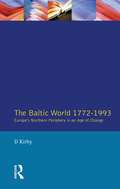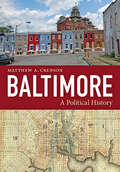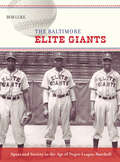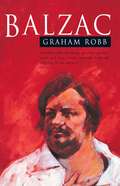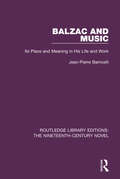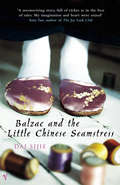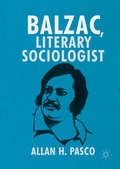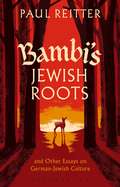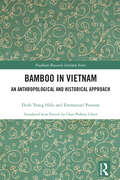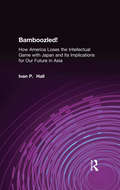- Table View
- List View
Balthazar Jones and the Tower of London Zoo
by Julia StuartA poignant, magical and completely original novel that you can’t fail to love, for fans of Joanne Harris.
The Baltic: A History
by Michael NorthFrom the Vikings to the EU the Baltic has been a Nordic Mediterranean, a shared maritime zone with distinct patterns of trade, cultural exchange, and conflict. Covering a thousand years in a part of the globe where seas are more connective than land, Michael North’s overview transforms the way we think about one of the world’s great waterways.
The Baltic: A History
by Michael NorthFrom the Vikings to the EU the Baltic has been a Nordic Mediterranean, a shared maritime zone with distinct patterns of trade, cultural exchange, and conflict. Covering a thousand years in a part of the globe where seas are more connective than land, Michael North’s overview transforms the way we think about one of the world’s great waterways.
Baltic Hospitality from the Middle Ages to the Twentieth Century: Receiving Strangers in Northeastern Europe (Palgrave Studies in Migration History)
by Christina Reimann Wojtek Jezierski Sari Nauman Leif RunefeltReflecting debate around hospitality and the Baltic Sea region, this open access book taps into wider discussions about reception, securitization and xenophobic attitudes towards migrants and strangers. Focusing on coastal and urban areas, the collection presents an overview of the responses of host communities to guests and strangers in the countries surrounding the Baltic Sea, from the early eleventh century to the twentieth. The chapters investigate why and how diverse categories of strangers including migrants, war refugees, prisoners of war, merchants, missionaries and vagrants, were portrayed as threats to local populations or as objects of their charity, shedding light on the current predicament facing many European countries. Emphasizing the Baltic Sea region as a uniquely multi-layered space of intercultural encounter and conflict, this book demonstrates the significance of Northeastern Europe to migration history.
The Baltic Nations and Europe: Estonia, Latvia and Lithuania in the Twentieth Century
by John Hiden Patrick SalmonOf all the Soviet Union's subject nationalities, the three Baltic republics, Estonia, Latvia and Lithuania, were the most determined and best organised in seizing the opportunities created by glasnost and perestroika to win freedom from Moscow's grip.At the time of first publication, in 1991, the final section of the book was speculative. Now for this revised edition, the authors have provided a new final chapter which brings the story up to date -- and the three republics to political independence again.
The Baltic Nations and Europe: Estonia, Latvia and Lithuania in the Twentieth Century
by John Hiden Patrick SalmonOf all the Soviet Union's subject nationalities, the three Baltic republics, Estonia, Latvia and Lithuania, were the most determined and best organised in seizing the opportunities created by glasnost and perestroika to win freedom from Moscow's grip.At the time of first publication, in 1991, the final section of the book was speculative. Now for this revised edition, the authors have provided a new final chapter which brings the story up to date -- and the three republics to political independence again.
The Baltic Prize: Thomas Kydd 19 (Thomas Kydd)
by Julian Stockwin1808. Parted from his new bride, Captain Sir Thomas Kydd is called away to join the Northern Expedition to Sweden, now Britain's only ally in the Baltic. Following the sudden declaration of war by Russia and with the consequent threat of the czar's great fleet in St Petersburg, the expedition must defend Britain's dearly-won freedom in those waters. However Kydd finds his popular fame as a frigate captain is a poisoned chalice; in the face of jealousy and envy from his fellow captains, the distrust of the commander-in-chief and the betrayal of friendship by a former brother-in-arms now made his subordinate, can he redeem his reputation?In an entirely hostile sea Tyger ranges from the frozen north to the deadly confines of the Danish Sound - and plays a pivotal role in the situation ensuing after the czar's sudden attack on Finland. This climaxes in the first clash of fleets between Great Britain and Russia in history. To the victor will be the prize of the Baltic!******************PRAISE FOR JULIAN STOCKWIN'S THOMAS KYDD SERIES'Paints a vivid picture of life aboard the mighty ship-of-the-line' Daily Express'This heady adventure blends fact and fiction in rich, authoritative detail' Nautical Magazine on VICTORY'Fans of fast-paced adventure will get their fill with this book' Historical Naval Society on THE ADMIRAL'S DAUGHTER
The Baltic States: Estonia, Latvia and Lithuania (Postcommunist States and Nations #3)
by Thomas Lane Artis Pabriks Aldis Purs David J. SmithSince the end of the Cold War there has been an increased interest in the Baltics. The Baltic States brings together three titles, Estonia, Latvia and Lithuania, to provide a comprehensive and analytical guide integrating history, political science, economic development and contemporary events into one account. Since gaining their independence, each country has developed at its own pace with its own agenda and facing its own obstacles. The authors examine the tensions accompanying a post-communist return to Europe after the long years of separation and how each country has responded to the demands of becoming a modern European state. Estonia was the first of the former Soviet republics to enter membership negotiations with the European Union in 1988 and is a potential candidate for the next round of EU expansion in 2004. Lithuania and Latvia have also expressed their desire for future membership of NATO and the EU.
The Baltic States: Estonia, Latvia and Lithuania (Postcommunist States and Nations)
by Thomas Lane Artis Pabriks Aldis Purs David J. SmithSince the end of the Cold War there has been an increased interest in the Baltics. The Baltic States brings together three titles, Estonia, Latvia and Lithuania, to provide a comprehensive and analytical guide integrating history, political science, economic development and contemporary events into one account. Since gaining their independence, each country has developed at its own pace with its own agenda and facing its own obstacles. The authors examine the tensions accompanying a post-communist return to Europe after the long years of separation and how each country has responded to the demands of becoming a modern European state. Estonia was the first of the former Soviet republics to enter membership negotiations with the European Union in 1988 and is a potential candidate for the next round of EU expansion in 2004. Lithuania and Latvia have also expressed their desire for future membership of NATO and the EU.
The Baltic States: The National Self-Determination of Estonia, Latvia and Lithuania
by Graham SmithThe Baltic States examines the struggles of the Baltic peoples for national self-determination. It is divided into two parts. Part one explores their nationalist awakening, how the realization of national self-determination during the inter-war years of independent statehood manifested itself, and the impact that fifty years of subsequent incorporation into the Soviet Union has had on Baltic politics and national cultures. Part two examines the nationalist reawakening in the late 1980s, the re-establishment of Baltic national self-governance in 1990-91 and the problems that these countries now face as sovereign entities.
The Baltic World 1772-1993: Europe's Northern Periphery in an Age of Change
by David KirbyThis eagerly-awaited sequel shares the characteristics of its distinguished predecessor -- wide geographical and chronological span; expert mingling of political, social and economic history; and Dr Kirby's ability to keep the separate national threads of his account from tangling as he weaves them into the broad regional picture that is his main concern. Here he tackles the contrasting experiences of Europe's northern periphery -- affluence and democracy in the north, stagnation and authoritarianism in the south -- from the French Revolution to the collapse of the USSR and beyond. This is a masterly study of a region that is far from peripheral politically to the post-Soviet world.
The Baltic World 1772-1993: Europe's Northern Periphery in an Age of Change
by David KirbyThis eagerly-awaited sequel shares the characteristics of its distinguished predecessor -- wide geographical and chronological span; expert mingling of political, social and economic history; and Dr Kirby's ability to keep the separate national threads of his account from tangling as he weaves them into the broad regional picture that is his main concern. Here he tackles the contrasting experiences of Europe's northern periphery -- affluence and democracy in the north, stagnation and authoritarianism in the south -- from the French Revolution to the collapse of the USSR and beyond. This is a masterly study of a region that is far from peripheral politically to the post-Soviet world.
Baltimore: A Political History
by Matthew A. CrensonCharm City or Mobtown? People from Baltimore glory in its eccentric charm, small-town character, and North-cum-South culture. But for much of the nineteenth century, violence and disorder plagued the city. More recently, the 2015 death of Freddie Gray in police custody has prompted Baltimoreans;¢;‚¬;€?and the entire nation;¢;‚¬;€?to focus critically on the rich and tangled narrative of black;€“white relations in Baltimore, where slavery once existed alongside the largest community of free blacks in the United States.Matthew A. Crenson, a distinguished political scientist and Baltimore native, examines the role of politics and race throughout Baltimore's history. From its founding in 1729 up through the recent past, Crenson follows Baltimore's political evolution from an empty expanse of marsh and hills to a complicated city with distinct ways of doing business. Revealing how residents at large engage (and disengage) with one another across an expansive agenda of issues and conflicts, Crenson shows how politics helped form this complex city's personality.Crenson provocatively argues that Baltimore's many quirks are likely symptoms of urban underdevelopment. The city's longtime domination by the general assembly;¢;‚¬;€?and the corresponding weakness of its municipal authority;¢;‚¬;€?forced residents to adopt the private and extra-governmental institutions that shaped early Baltimore. On the one hand, Baltimore was resolutely parochial, split by curious political quarrels over issues as minor as loose pigs. On the other, it was keenly attuned to national politics: during the Revolution, for instance, Baltimoreans were known for their comparative radicalism. Crenson describes how, as Baltimore and the nation grew, whites competed with blacks, slave and free, for menial and low-skill work. He also explores how the urban elite thrived by avoiding, wherever possible, questions of slavery versus freedom;¢;‚¬;€?just as wealthier Baltimoreans, long after the Civil War and emancipation, preferred to sidestep racial controversy. Peering into the city's 300-odd neighborhoods, this fascinating account holds up a mirror to Baltimore, asking whites in particular to reexamine the past and accept due responsibility for future racial progress.
Baltimore: A Political History
by Matthew A. CrensonCharm City or Mobtown? People from Baltimore glory in its eccentric charm, small-town character, and North-cum-South culture. But for much of the nineteenth century, violence and disorder plagued the city. More recently, the 2015 death of Freddie Gray in police custody has prompted Baltimoreans;¢;‚¬;€?and the entire nation;¢;‚¬;€?to focus critically on the rich and tangled narrative of black;€“white relations in Baltimore, where slavery once existed alongside the largest community of free blacks in the United States.Matthew A. Crenson, a distinguished political scientist and Baltimore native, examines the role of politics and race throughout Baltimore's history. From its founding in 1729 up through the recent past, Crenson follows Baltimore's political evolution from an empty expanse of marsh and hills to a complicated city with distinct ways of doing business. Revealing how residents at large engage (and disengage) with one another across an expansive agenda of issues and conflicts, Crenson shows how politics helped form this complex city's personality.Crenson provocatively argues that Baltimore's many quirks are likely symptoms of urban underdevelopment. The city's longtime domination by the general assembly;¢;‚¬;€?and the corresponding weakness of its municipal authority;¢;‚¬;€?forced residents to adopt the private and extra-governmental institutions that shaped early Baltimore. On the one hand, Baltimore was resolutely parochial, split by curious political quarrels over issues as minor as loose pigs. On the other, it was keenly attuned to national politics: during the Revolution, for instance, Baltimoreans were known for their comparative radicalism. Crenson describes how, as Baltimore and the nation grew, whites competed with blacks, slave and free, for menial and low-skill work. He also explores how the urban elite thrived by avoiding, wherever possible, questions of slavery versus freedom;¢;‚¬;€?just as wealthier Baltimoreans, long after the Civil War and emancipation, preferred to sidestep racial controversy. Peering into the city's 300-odd neighborhoods, this fascinating account holds up a mirror to Baltimore, asking whites in particular to reexamine the past and accept due responsibility for future racial progress.
The Baltimore Elite Giants: Sport and Society in the Age of Negro League Baseball
by Bob LukeOne of the best-known teams in the old Negro Leagues, the Elite Giants of Baltimore featured some of the outstanding African American players of the day. Sociologist and baseball writer Bob Luke narrates the untold story of the team and its interaction with the city and its people during the long years of segregation.To convey a sense of the action on the field and the major events in the team’s history, Luke highlights important games, relives the standout performances of individual players, and discusses key decisions made by management. He introduces the team’s eventual major league stars: Roy Campanella, who went on to a ten-year Hall of Fame career with the Brooklyn Dodgers; Joe Black, the first African American pitcher to win a World Series game; and James "Junior" Gilliam, a player and coach with the Dodgers for twenty-five years. Luke also describes the often contentious relationship between the team and major league baseball before, during, and after the integration of the major leagues.The Elite Giants did more than provide entertainment for Baltimore’s black residents; the team and its star players broke the color barrier in the major leagues, giving hope to an African American community still oppressed by Jim Crow. In recounting the history of the Elite Giants, Luke reveals how the team, its personalities, and its fans raised public awareness of the larger issues faced by blacks in segregation-era Baltimore. Based on interviews with former players and Baltimore residents, articles from the black press of the time, and archival documents, and illustrated with previously unpublished photographs, The Baltimore Elite Giants recounts a barrier-breaking team’s successes, failures, and eventual demise.
Balzac
by Graham RobbGraham Robb has produced a masterpiece literary biography in which Balzac bursts into life on every page. The living manifestation of the colourful and varied world he described, yet at the same time its most astonishing exception, Balzac is the perfect subject for biography. Robb skilfully interweaves the life with the work to paint an indelible and brilliantly compelling portrait of one of the great tragicomic heroes of the nineteenth century, a man whose influence both in and outside his native France has been and is still immense.
Balzac and Music: Its Place and Meaning in His Life and Work (Routledge Library Editions: The Nineteenth-Century Novel)
by Jean-Pierre BarricelliFirst published in 1990, this book was the first comprehensive study of Balzac’s relationship to music, blending past scholarship with new perspectives to formulate an inclusive account. It begins by examining the contacts and experiences that shaped the musical side of Balzac’s life. These left valuable and lasting impressions which often found their way into his writings, where he recorded a myriad of critical and musicological opinions — assessed primarily in relation to Gambara and Massimilla Doni. These discussions prepare the way for an analysis of Balzac two major musical persuasions: religious music and Beethoven. This book will be of interest to students of literature and music.
Balzac and Music: Its Place and Meaning in His Life and Work (Routledge Library Editions: The Nineteenth-Century Novel)
by Jean-Pierre BarricelliFirst published in 1990, this book was the first comprehensive study of Balzac’s relationship to music, blending past scholarship with new perspectives to formulate an inclusive account. It begins by examining the contacts and experiences that shaped the musical side of Balzac’s life. These left valuable and lasting impressions which often found their way into his writings, where he recorded a myriad of critical and musicological opinions — assessed primarily in relation to Gambara and Massimilla Doni. These discussions prepare the way for an analysis of Balzac two major musical persuasions: religious music and Beethoven. This book will be of interest to students of literature and music.
Balzac and the Little Chinese Seamstress
by Dai Sijie1971: Mao's cultural Revolution is at its peak. Two sons of doctors, sent to 're-education' camps, forced to carry buckets of excrement up and down mountain paths, have only their sense of humour to keep them going. Although the attractive daughter of the local tailor also helps to distract them from the task at hand. The boys' true re-education starts, however, when they discover a hidden suitcase packed with the great Western novels of the nineteenth century. Their lives are transformed. And not only their lives: after listening to the stories of Balzac, the little seamstress will never be the same again.
Balzac, Literary Sociologist
by Allan H. PascoMelding the fields of literature, sociology, and history, this book develops analyses of the ten novels in Balzac's Scènes de la vie de province. Following the order of the novels projected in La Comédie humaine, Allan H. Pasco investigates how Balzac used art as a tool of social inquiry to obtain startlingly accurate insights into the relationships that defined his turbulent society. His repeated claim to be an "historian of manners" was more than an empty boast. Though Balzac was first and foremost a great novelist, he was also a trailblazing sociologist, joining Henri de Saint-Simon and the subsequent Auguste Comte in considering the relationships that represent society as an interacting, interlocking web. Using a methodology that combines close analysis with a broad cultural context, Pasco demonstrates that Balzac's sociological vision was extraordinarily pertinent to both his and our days.
Bambi's Jewish Roots and Other Essays on German-Jewish Culture
by Paul ReitterPaul Reitter has won acclaim as both a scholar and a public critic for his writing on German Jewish culture in the twentieth century. Bambi's Jewish Roots brings together the best of Reitter's essayistic work, exploring the lives of well-known figures and revealing surprising new perspectives. These include how Felix Salten's Zionist commitments manifest themselves in his most famous work, the novel Bambi; what Gershom Scholem's diaries tell us about his development as a thinker and person; why German-Jewish writers hated Stefan Zweig so passionately; where myth-busting books about Franz Kafka have indulged in myth-building; how Freud's Moses and Monotheism offers a theory of Jewish self-hatred more than an explanation of anti-Semitism; and why Heinrich Heine felt aburning need to distance himself from his fellow liberal Jewish critic Ludwig Börne.The works collected here, many of which were originally published in forums such as the New York Review of Books, London Review of Books, the Times Literary Supplement, The Nation, Harper's Magazine, and the Jewish Review of Books, have earned Reitter his reputation as a witty, erudite, and deeply illuminating critic.
Bambi's Jewish Roots and Other Essays on German-Jewish Culture
by Paul ReitterPaul Reitter has won acclaim as both a scholar and a public critic for his writing on German Jewish culture in the twentieth century. Bambi's Jewish Roots brings together the best of Reitter's essayistic work, exploring the lives of well-known figures and revealing surprising new perspectives. These include how Felix Salten's Zionist commitments manifest themselves in his most famous work, the novel Bambi; what Gershom Scholem's diaries tell us about his development as a thinker and person; why German-Jewish writers hated Stefan Zweig so passionately; where myth-busting books about Franz Kafka have indulged in myth-building; how Freud's Moses and Monotheism offers a theory of Jewish self-hatred more than an explanation of anti-Semitism; and why Heinrich Heine felt aburning need to distance himself from his fellow liberal Jewish critic Ludwig Börne.The works collected here, many of which were originally published in forums such as the New York Review of Books, London Review of Books, the Times Literary Supplement, The Nation, Harper's Magazine, and the Jewish Review of Books, have earned Reitter his reputation as a witty, erudite, and deeply illuminating critic.
Bamboo in Vietnam: An Anthropological and Historical Approach (Needham Research Institute Series)
by Đinh Trọng Hiếu Emmanuel PoissonThis book presents interdisciplinary research on bamboo in Vietnam, drawing on the anthropology of gesture, ethnobotany and the history of technology. The authors have adopted a technological approach which reviews how the terminology of different parts of the bamboo plant in the dictionaries in Romanized Vietnamese or in Vietnamese vernacular writing (nôm) enabled the authors to identify not only the plant but also each technical gesture for its appropriation by the artisan. Lithographic, literary and historical sources from the chronicles have been mobilized to illustrate the many uses of this versatile plant. Richly illustrated throughout, this book will appeal to students and scholars of Vietnam, anthropology, the history of science and technology, environmental history and architecture. It will also be of great value to those interested in the applications of bamboo in the contemporary world.
Bamboo in Vietnam: An Anthropological and Historical Approach (Needham Research Institute Series)
by Đinh Trọng Hiếu Emmanuel PoissonThis book presents interdisciplinary research on bamboo in Vietnam, drawing on the anthropology of gesture, ethnobotany and the history of technology. The authors have adopted a technological approach which reviews how the terminology of different parts of the bamboo plant in the dictionaries in Romanized Vietnamese or in Vietnamese vernacular writing (nôm) enabled the authors to identify not only the plant but also each technical gesture for its appropriation by the artisan. Lithographic, literary and historical sources from the chronicles have been mobilized to illustrate the many uses of this versatile plant. Richly illustrated throughout, this book will appeal to students and scholars of Vietnam, anthropology, the history of science and technology, environmental history and architecture. It will also be of great value to those interested in the applications of bamboo in the contemporary world.
Bamboozled!: How America Loses the Intellectual Game with Japan and Its Implications for Our Future in Asia
by Ivan P. HallAs the influence of the United States in Asia declines with the end of the Cold War, America must look more to brains than military might in achieving our objectives in the region. But after repeatedly allowing Japan - our closest ally in Asia - to mislead us intellectually and psychologically, how well are we prepared to deal with less friendly emerging powers like China and India? Based on three decades of on-the-spot observation and participation in Japan, Ivan Hall's provocative work draws the reader into a world of intellectual manipulation and gullibility, false images, emotional blackmail, financial beguilement, and fatuous expectations. It illuminates the many ways that American ideological hubris and Japanese pleading for special treatment combine to deprive our trans-Pacific dialogue of the honesty, openness, and plain common sense of our trans-Atlantic intellectual ties with Europe.
